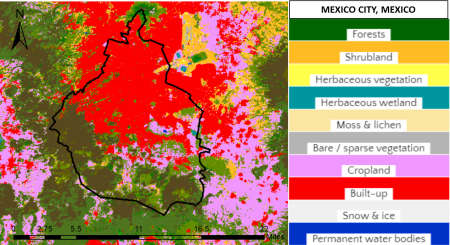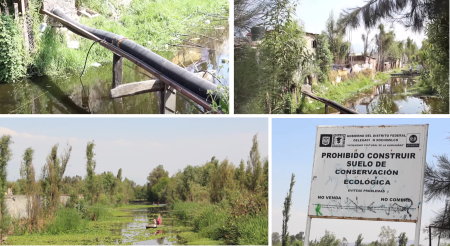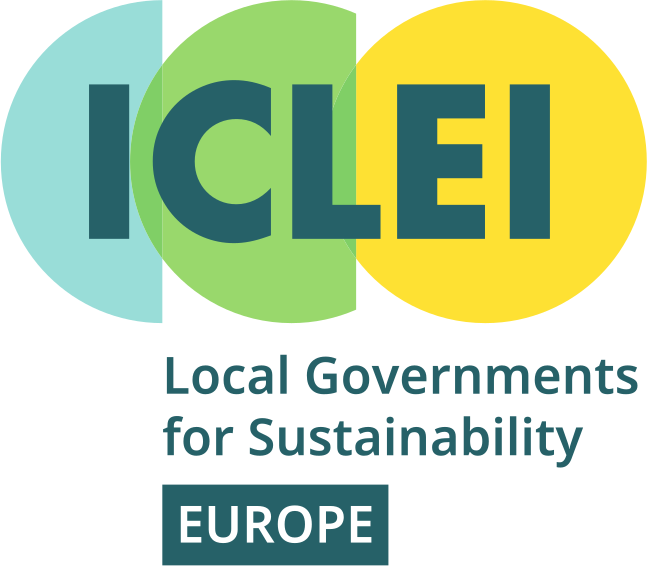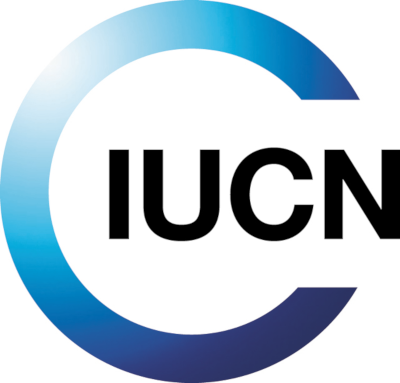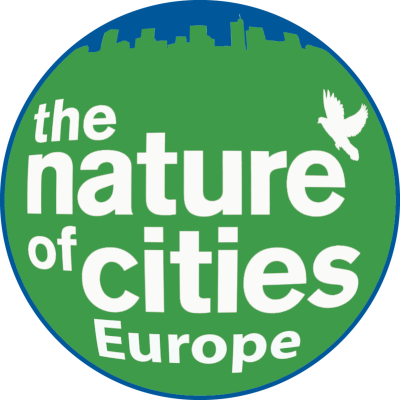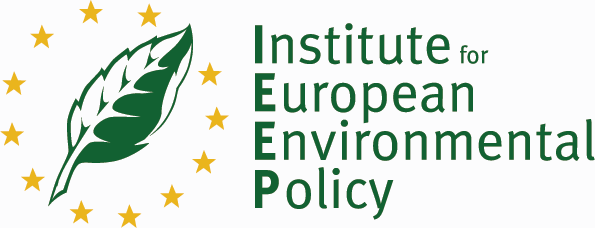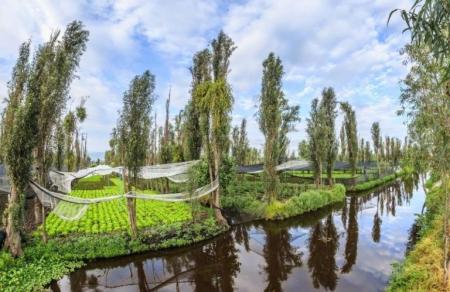
Area characterisation:
Mexico City is one of the world's most populated areas (close to 25 million people). It is also the country's cultural, economic, and industrial centre. The biggest challenge of the city is managing the needs of the increasing population associated with the urban sprawl. In connection to this, a major concern is the water-related pollution and stress caused by the city's development. In Mexico City, events such as flooding, water shortages, droughts, low water quality, surface and groundwater degradation are frequent. Also related to this are issues such as: the depletion of groundwater resources in the regional aquifers; subsidence associated with the high groundwater abstraction rates; high costs related to long-distance transportation of potable water and wastewater; inefficiency caused by substantial leaks from the water supply system; insufficient wastewater treatment capacity; a lack of infrastructure for water reuse and; limited storage of rain-water.
These socio-environmental problems increase at rate with the expansion of the Mexico city. The growing population and the income per capita intensify the demand for goods and services which places pressure on natural resources and ecosystems. This is particularly case forthe Heritage Zone of Xochimilco which including the areas of the Municipality of Xochimilco (49.6% of the polygon is in Xochimilco), Tláhuac (48.8%), and Milpa Alta (1.4%).
Xochimilco is facing threats due to high levels of environmental degradation and increasing pressures due to the expansion of informal settlements, which resulted in an inadequate provision of urban services. Therefore, Xochimilco faces highly dynamic vulnerability and fragility, placing even its existence is at risk. The original water system has changed, and the traditional land use has come under significant pressure due to urbanisation and a lack of sanitation. The urban growth, the increasing pressure of associated land uses, the discharge of household drainage to the canals, the malfunction of the treatment plant, and other related issues could cause Xochimilco to disappear in the future. Invasive species (e.g. carp and tilapia) in Xochimilco waters are predators of the Ajolotes (Ambystoma mexicanum) and also cause erodsion of the canals’ bottom and damage to the borders on the banks where these species lay their eggs, resulting in a loss of land and plant diversity.
Objective:
Xochimilco is an important tourist attraction for Mexico City and because of this public policies have been focused in conservation, tourism infrastructure and ecotourism. Therefore there is now a priority to address social and environmental challenges including: the dredging and cleaning of the canals, garbage collection and reforestation of channels, exotic species control, improving the hydraulic infrastructure, Axolotl conservation, Chinampas rehabilitation, and productive projects.
Natural systems or nature based solution have been suggested and implemented in order to reduce the presence of pollutants in the environment, maintaining the conservation of native species and ecosystems; and mitigating problems in Xochimilco. This integrated approach to resolving threats has been focused on flood prevention, water supply, water quality, drinking water supply, wastewater treatment, risk prevention, and urban planning.
Images
Financing:
No information to display
Potential impacts/benefits:
The key benefits of interventions relate to:
- Maintaining Biodiversity.
- Increasing quality and quantity of green and blue infrastructures.
- Improvinhg connectivity and functionality of green and blue infrastructures.
- Reducing costs for water treatments.
- Improving water quality.
- Increasing well-being.
- Increasing willingness to invest in NbS.
- Increasing awareness of NbS solution & their effectiveness and co benefits.
- Reducing the load to the sewerage system.
- Flood peak reduction.
- Reduced drought risk.
- Reduced flood risk.
- Increasing infiltration / Water storage.
Actions:
Some initiatives using NbS to provide a structural and functional restoration of water ecosystem in Xochimilco are:
a) Reconnection of the Rio Amecameca to increase water volume for water management, allowing the river water to flow, combined with infrastructure to direct the water to the right areas of the heritage zone. In this sense, this intervention improves the quality of the water that flows into the area. The water quality improvement is likely to be carried out with the localised treatment of river water, such as a combination of decentralised wastewater treatment plants and purification of wetlands. The expected impacts of this are to reduce water shortages, to better control of water levels, improve water quality and ecosystem health. On the socio-economic front, this intervention can improve agriculture, tourist navigation, recreation, and health. It can also contribute to the conservation of biodiversity and endemic species, help with the irrigation and maintenance of chinampa groundwater levels, keep sufficiently high water levels in the channels and prevent stagnant areas.
The research is moving on to the use of natural coagulants obtained from the seeds of Moringa oleifera. In addition to their effect as coagulants, these seeds absorb filter materials, and have an inhibiting effect on pathogenic micro-organisms. The ultimate goal is to have an alternative to treat water using a natural and economic system, and reducing fecal pollution in water used for agriculture. Such a system could disinfect the outflow effluents of treatment wetlands and biofilters, allowing the reuse for agriculture.
b) Convert and enable the streets bordering the Xochimilco channels as passive treatment systems for the wastewater from surrounding houses enabling the discharge of clean water into the wetland's canals. Enable sewage treatment systems of a semi-passive nature under the fixed bed principle (biofilm reactor) in the streets next to the canals. Enable biodigester batteries to give primary treatment to wastewater. Deliver high-quality clean water to the channels.
c) Ecological restoration by green corridors that follow the original streams' valleys which flow from the springs at the Teutle Volcano's foothills in the Xochimilco chinampa area. The water flowing through these green corridors feeds the chinampa area. The former springs that are now dry because of groundwater abstraction but can be partially restored to feed the corridors. The corridors also work as linear parks that connect the urban public space, south of the Xochimilco heritage zone, with the Unesco World Heritage Zone.
Transferability of result:
This study case provides potential actions as well as results and lessons that can be upscaled in other wetlands blue infrastructures in the central Mexican region.
Lessons learnt:
- The local, technical, and scientific communities are working to stop the Xochimilco social and environmental threats. However, the pressure of the urban expansion and the high demand for water and food does not stop. These issues highlight the over-simplification that characterises the rationale behind environmental policy and the limitations associated with short-term perspectives, eluding political costs and the lack of social and environmental indicators to evaluate performance.
- Every initiative mentioned in this case study needs to be pushed by the local and national authorities. Education, economic investment, and continued research could improve the Xochimilco area and create a functional ecosystem.
- The feasibility, efficiency, and adequacy of policies may depend on these processes. City growth can lead to different urbanisation intensities and ecological restoration decisions.
- In Mexico, urban sprawl and urban and territorial planning of cities are poorly managed: regulatory actions are remedial and not preventive. Promoting effective urban and territorial planning legislation must be a clear goal of policy for improving Mexican cities' sustainability.
Organisations:
Ciudad de Mexico: https://www.cdmx.gob.mx/
Xochimilco: https://whc.unesco.org/en/list/412/
Agriculture in Chinampas: https://www.gob.mx/agricultura/es/articulos/la-agricultura-en-chinampas
Water in Xochimilco: https://es.unescosost.org/post/recuperaci%C3%B3n-del-agua-en-xochimilco-m%C3%A9xico
Milpa Alta: https://antropologiachinampera.wordpress.com/2014/10/23/bienvenidos/
Contacts:
Lilia Roa-Fuentes
Pontificia Universidad Javeriana Bogota
Bogotá, Colombia
Global goals:
-
11. Sustainable cities and communities
NBS goals:
- Enhancing sustainable urbanization
- Restoring ecosystems and their functions
- Developing climate change adaptation
- Improving risk management and resilience
- Urban regeneration through nature-based solutions
- Multi-functional nature-based watershed management and ecosystem restoration
NBS benefits:
- Developing climate change adaptation; improving risk management and resilience
- Restoring ecosystems and their functions
- Enhancing sustainable urbanisation
Publications and reports:
- Rubio, Fernanda Figueroa & Luis Zambranoc (2020) Dissonant Views of Socioecological Problems: Local Perspectives and Conservation Policies in Xochimilco, Mexico. Conservation & Society 18(3) 207-219
- Gehrels, ten Velden C., Meijer D., Sánchez M. et al.(2019). A Water Resilience Plan For The Heritage Zone Of Xochimilco, Tlahuac And Milpa Alta. Prepared by: DELTARES, UAM, ERN, Keystone and Barraza
- Estrada, F., Velasco, J. A., Martinez-Arroyo, A., & Calderón-Bustamante, O. (2020). An Analysis of Current Sustainability of Mexican Cities and Their Exposure to Climate Change. Frontiers in Environmental Science, 8, 25.

